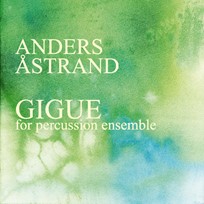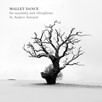
Gigue
Composer: Anders Åstrand
Instrument: Percussion Ensemble
Level: Intermediate
Published: 2011
Price: €32.00
Item details
-
Description +
-
Duration: 6 min.
Gigue commissioned by Brett Dietz for the Lousiana State University School of Music, Percussion Ensemble. The premiere was March 20, 2008 at Louisiana State University. Commissioned by Hamiruge - The LSU Percussion Group. Brett Dietz, Director.
-
-
Instrumentation +
-
Percussion Ensemble (8 players)
Required Instruments:
1 Glockenspiel
1 Xylophone
2 Vibraphones
3 Marimbas (including one 5 octave marimba)
2 Bongos
It is optional to add shakers, cajon, handdrums. The solo cadenza can either be a vibraphone cadenza, percussion cadenza or a collective improvisation.
-
-
About the composer +
-
As a mallet specialist, Åstrand regularly performs recitals and gives clinics throughout the US and Europe, both as a soloist and together with his percussion ensemble Global Percussion Network. Anders Åstrand has several times performed at PASIC (Percussive Arts Society International Convention).
In his compositions, Åstrand focuses on improvisation as an essential feature for soloists as well as the ensemble. In addition to mallet music, Åstrand has been commissioned to composes for brass quintets, saxophone quartet, choirs, and big band. A more spectacular side features compositions for ice instruments to be performed by percussion ensemble (one of the concerts also featured fighter aircraft as instruments), tractors, and an entire building being inaugurated. Åstrand has also composed music for multimedia performances including dance, video projections, ice instruments, and fire sculptures.
-
-
Reviews +
-
Percussive Notes, May, 2012
At first glance, this work might look quite difficult. It is full of sixteenth-note patterns; some of them are quite angular, and the texture is dense throughout. However, the piece is actually very accessible for most intermediate to advanced players.
The piece is in 6/8 with the dotted quarter note at 66–72. Other instruments such as shakers or hand drums can be added if desired. Two-mallet techniques can be used throughout except for the second vibe part, which requires four mallets.
The musical vocabulary could be described as pandiatonic, with whole sections centering on one major scale area. Rhythms and melodic patterns are often repetitious, creating a minimalist effect, then the tonality shifts creating a new soundscape. Often, all the instruments are playing with much doubling. At one point, vibraphone II has an improvised solo that ends in a cadenza. The composer states that this “can either be a vibraphone cadenza, percussion cadenza, or a collective improvisation.” After the cadenza, the same kind of material returns and the piece ends with two chords held by fermatas.
There is little dynamic indication, but a good director could add appropriate dynamics for the ensemble. Because of the repetitive nature of the piece, once a difficult pattern is learned, the player often repeats that pattern several times before moving to another. The work will require rhythmic precision and melodic accuracy.
—Tom Morgan
-
-
Credits +
-
Front Cover graphics and layout: Ronni Kot Wenzell
Engraving: Johan Svitzer
Printed in Copenhagen, Denmark
Copyright © Edition SVITZER
www.editionsvitzer.com
-




